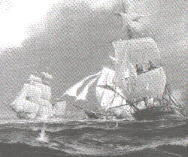


Commodore Isaac Chauncey locates the British ships on the morning of September 28th and sets a northerly coarse to intercept. Around noon both commanders form their lines of battle. For the Americans the "Pike", towing the "Asp" is in the lead. Followed by the "Sylph", towing the "Ontario", the "Madison", the "Onieda", "Governor Tompkins" and three other schooners. The British line had the "Wolfe" in the lead followed by the "Royal George", "Melville", "Moira", "Beresford" and the "Sir Sydney Smith".
The two fleets moved south near York when the American commander made his move towards the British Flagship. When the "Pike" was directly opposite the "Wolfe" Yeo turned the ship around and brought the starboard side to the wind aiming away from the "Pike", now he headed for the middle and end of Chauncey's line. The "Pike" turned and went after Yeo's ship.
The British Flagship fired first. After the first shot was fired the rest of the ships joined in the battle, with all the British guns being aimed at the "Pike".
The American ship at this moment could only return fire with three guns. Sinclair and Chauncey stayed calm and continued on toward the British Flagship.
When they were in position they turned the "Pike" and blasted the "Wolfe" with fourteen long 24 pdrs., sending round and chain-shot crashing into her. The "Wolfe" reeled but returned fire. Just after 1 p.m. the American flagship had it's topsail damaged.
The two ships exchanged broadsides again this time the "Wolfe" was severely damaged. The Americans moved into finish off the British flagship, when up came Commander William Mulcaster in the "Royal George". He maneuvered his ship in between the "Pike" and the "Wolfe" bringing it to a near stop and hammered the American vessel with broadside after broadside. The "Melville" and the "Moira" also blasted away at the Americans until the "Pike" veered away. The "Govenor Tompkins", "Madison" and "Onieda" were involved in the battle at this point.
The crew of the "Wolfe" pulled themselves together after being dazed and steered their ship towards Burlington Bay. They made the necessary repairs and the ship soon had enough speed to pull away from the Americans who were in pursuit.
The rest of the British squadron had turned to follow the damaged "Wolfe". The "Pike" maintained contact firing at any and all the British ships when they were in range.
Because the other U.S. ships were towing schooners they fell back and were not as much of a threat to the British squadron.
After three hours Yeo pulled the battered "Wolfe" into Burlington Bay, Chauncey breaks off the pursuit. This ends what has become known as the "Burlington Races".
The British cassualties not including the dead thrown overboard during the battle are 6 dead 12 wounded.
The American casualties reported by Chauncey are 27.